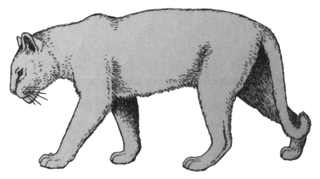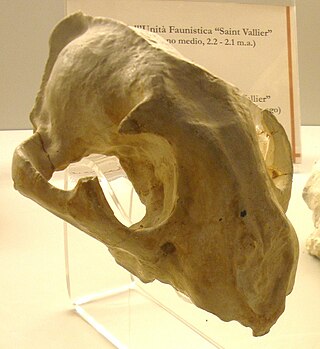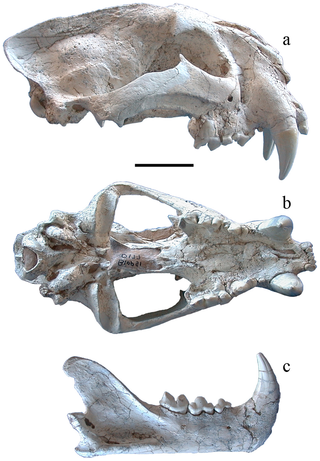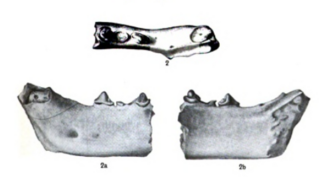Panthera is a genus within the family Felidae, it is one of two extant genera in the subfamily Pantherinae, and contains the largest living members of the cat family. There are 5 living species, the tiger, jaguar, lion, leopard and snow leopard and a number of extinct species.

Acinonyx is a genus within the Felidae family. The only living species of the genus, the cheetah, lives in open grasslands of Africa and Asia.

Dinofelis is an extinct genus of machairodontine, usually classified in the tribe Metailurini. It was widespread in Europe, Asia, Africa and North America from 5 million to about 1.2 million years ago. Fossils very similar to Dinofelis from Lothagam range back to around 8 million years ago, in the Late Miocene.

Panthera atrox, better known as the American lion, also called the North American lion, or American cave lion, is an extinct pantherine cat. Panthera atrox lived in North America during the Pleistocene epoch, from around 340,000 to 12,800 years ago. The species was initially described by American paleontologist Joseph Leidy in 1853 based on a fragmentary mandible (jawbone) from Mississippi; the species name ('atrox') means "savage" or "cruel". The status of the species is debated, with some mammalogists and paleontologists considering it a distinct species or a subspecies of Panthera leo, which contains living lions. However, novel genetic evidence has shown that it is instead a distinct species derived from the Eurasian cave or steppe lion, evolving after its geographic isolation in North America. Its fossils have been excavated from Alaska to Mexico. It was about 25% larger than the modern lion, making it one of the largest known felids.
Paramachaerodus is an extinct genus of saber-tooth cat of the subfamily Machairodontinae, which was endemic to Europe and Asia during the Middle and Late Miocene from 15 to 9 Ma. A 2022 phylogenetic analysis suggested that the genus may be polyphyletic.

The Pantherinae is a subfamily of the Felidae; it was named and first described by Reginald Innes Pocock in 1917 as only including the Panthera species. The Pantherinae genetically diverged from a common ancestor between 9.32 to 4.47 million years ago and 10.67 to 3.76 million years ago.

Panthera gombaszoegensis, also known as the European jaguar, is a Panthera species that lived from about 2.0 to 0.35 million years ago in Europe The first fossils were excavated in 1938 in Gombasek, Slovakia. P. gombaszoegensis was medium-large sized species that formed an important part of the European carnivore guild for a period of over a million years. Many authors have posited that the species is the ancestor of the American jaguar, with some authors considering it the subspecies Panthera onca gombaszoegensis, though the close relationship between the two species has been questioned.
Panthera palaeosinensis was an early Pleistocene species from northern China. It is often incorrectly referenced as the ancestor of the tiger, Panthera tigris, although it shares features with all living large cats. Recent studies place it close to the base of the genus Panthera.

Puma pardoides is an extinct prehistoric cat in the cougar genus Puma known from fossils found across Eurasia.

Acinonyx pardinensis, sometimes called the Giant cheetah, is an extinct felid species belonging to the genus Acinonyx, closely related to the cheetah, native to Eurasia during the Pliocene and Pleistocene epochs. It was substantially larger than the living cheetah.

Xenocyon is an extinct group of canids, either considered a distinct genus or a subgenus of Canis. The group includes Canis (Xenocyon) africanus, Canis (Xenocyon) antonii and Canis (Xenocyon) falconeri that gave rise to Canis (Xenocyon) lycanoides. The hypercarnivorous Xenocyon is thought to be closely related and possibly ancestral to modern dhole and the African wild dog, as well as the insular Sardinian dhole.
Acinonyx intermedius is a fossil species of felid belonging to the cheetah genus Acinonyx. It was described by paleontologist Thenius in 1954. It is sometimes considered part of Acinonyx pardinensis as A. p. intermedius.

Panthera zdanskyi is an extinct pantherine species, the fossils of which were excavated in Gansu Province, northwestern China. Due to its close relationship with the modern tiger, it is called the Longdan tiger.
Panthera tigris acutidens or Wanhsien tiger is an extinct tiger subspecies, which was scientifically described in 1928 based on fossils excavated near Wanhsien in southern China's Sichuan Province. Otto Zdansky named it Felis acutidens. After the fossils were re-examined in 1947, they were attributed to Panthera tigris acutidens by Dirk Albert Hooijer and Walter W. Granger.

Panthera blytheae is an extinct species of pantherine felid that lived during the late Messinian to early Zanclean ages approximately 5.95–4.1 million years ago.The first fossils were excavated in August 2010 in the Zanda Basin located in the Ngari Prefecture on the Tibetan Plateau; they were described and named in 2014.
Yoshi is an extinct genus of machairodontine sabertooth cat in the tribe Metailurini. Its fossils were described from Turolian deposits from the Miocene epoch of the Balkan Peninsula in 2014 and specimens from China once thought to belong to Metailurus. The name comes from that of the lead author's pet cat. It has been described as potentially being synonymous with Metailurus, though this is difficult to confirm at present. The type specimen is a skull that bears remarkable similarities with the modern cheetah. Yoshi is intermediate in size between a lynx and cougar, and based on several as-yet unpublished skeletons, may have had a similar lifestyle to the cheetah, being better built for speed and fast pursuit than most other machairodonts, which were more suited to ambush and hunting large, relatively slow moving animals.
Miopanthera is an extinct genus of Pseudaelurus-grade felids.
Sivaelurus is a fossil genus of felid containing only a single species, S. chinjiensis, which was described based on a partial right maxilla collected from the Chinji Formation in the Lower Siwaliks. The species was originally described by Guy Ellcock Pilgrim as Pseudaelurus chinjiensis in 1910, who later erected a new genus, Sivaelurus, for it in 1913.
Sivapardus is an extinct, little-known genus of feline with only one species assigned to it, Sivapardus punjabiensis. It was described in 1969 by the paleontologist Abu Bakr based on a partial mandible from the Upper Siwaliks in Pakistan; the locality it was found at is estimated to be from the Late Pliocene to Early Pleistocene. S. punjabiensis was a large cat with a short and broad snout that may have lived on open grasslands.

Sivasmilus is a fossil genus of barbourofelid containing only a single species, Sivasmilus copei. It is known from only a single specimen, a partial mandible collected from the Chinji Formation in the Lower Siwaliks in Pakistan, estimated to be from the Miocene. The fossil was originally described in 1915 when it was assigned to the fossil feline Sivaelurus chinjiensis, but was used as the basis of a new genus and species in 1929 by Hungarian paleontologist Miklós Kretzoi. Sivasmilus copei was a relatively small, cat-like animal.










